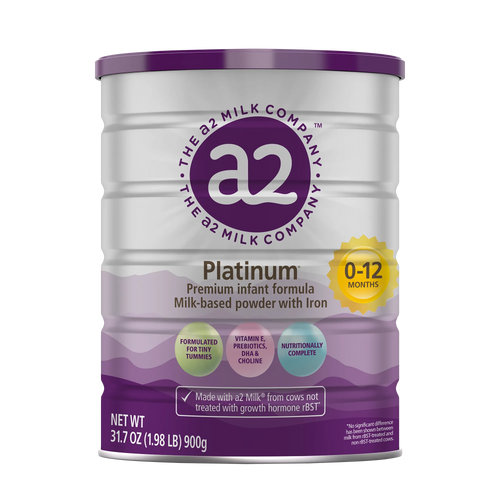How to Introduce a Sippy Cup
Reviewed by: Julie Ruelle, RD, LD
Picture this: Your baby's tiny hands reaching for your coffee mug as they watch you take a sip, their curious eyes widening with fascination. That's your first sign – your little one is ready to join the "grown-up cup club." But how do you bridge the gap between those familiar bottle nipples and their very own big kid cup?
You're about to embark on an adventure that's equal parts messy and magical – the sippy cup journey. This isn't just about teaching your baby a new skill; it's about watching them grasp (literally and figuratively) another piece of independence.
Navigating the world of sippy cups might feel like decoding a secret language – soft spouts, hard spouts, straw cups, oh my! But here's the secret: Your baby has already been dropping hints about their readiness. That gurgle of interest when they spot a sibling drink from their cup? That's your green light. Those determined attempts to grab your water glass during family meals? Your baby's basically shouting, "I'm ready for my own cup!"
Signs Your Baby is Ready to Introduce a Sippy Cup
According to the American Academy of Pediatrics, most babies are ready to use a sippy cup between 6 and 9 months of age. This transition period aligns naturally with your baby's developing motor skills and growing independence, and it goes hand in hand with your baby's overall developmental progress.
When your little one begins showing interest in your drinking vessels or reaching for cups during mealtimes, these are positive indicators they may be ready to start learning. Watch for these natural cues rather than forcing the transition before your baby shows genuine interest. If your child has started eating solid food or shows curiosity when they see a sibling drink from a cup, these are good signs to introduce a sippy cup.
Choosing the Right Sippy Cup for Your Baby
Once you recognize that your baby is ready for a sippy cup, the next critical step is selecting the right one. The material, design, and features of your chosen cup can significantly impact your success with this transition. Different sippy cups offer unique features that cater to various needs and preferences.
When selecting your baby's first sippy cup, consider these essential factors:
- Safety First: Choose plastic cups that are BPA-free and made with food-grade materials
- Spout Type: Start with a soft spout or flexible spout that resembles a bottle nipple
- Size and Weight: Select a lightweight cup with handles your baby can easily grasp
- Ease of Cleaning: Look for cups with a removable snap on lid or screw on lid for thorough cleaning
- Valve System: Consider a training cup with a valve that controls liquid flow
Different sippy cup styles serve different purposes. Some babies may prefer a silicone spout, while others adapt better to a hard spout. A straw cup can be excellent for older babies, while a soft-spout cup is ideal for those transitioning from bottle-feeding.
The Training Process for Using a Sippy Cup
Once you've selected the style of cup, you're ready to begin the training journey. The following step-by-step approach will help you guide your child through this important developmental milestone.
Starting With Small Steps
Introduce the sippy cup during snack times or regular mealtimes when your baby is alert but not overly hungry. Fill the cup with breast milk or formula initially, as the familiar taste will encourage your baby to try this new drinking method. You can teach your baby by demonstrating how to drink from the cup yourself and showing them how to hold and tilt it properly.
Offering breast milk in the sippy spout can make the transition more appealing for exclusively breastfed babies. Some parents find success by offering a few ounces in the sippy cup while continuing bottle feeding or nursing for other feedings.
Making the Transition Gradual
The key to a successful transition is patience and consistency. Here's how to gradually introduce the sippy cup:
- Morning Practice: Begin each day with a fresh opportunity to use the cup during breakfast
- Switch Halfway: During bottle feeding sessions, switch halfway to the sippy cup
- Consistent Timing: Offer the cup at the same times each day for predictability
- Positive Modeling: Show your baby how to use a sippy cup by drinking from your own regular cup
- Gentle Support: Help guide the cup filled with liquid to their mouth while allowing them to grip it themselves
- Celebration: Praise their efforts and progress, no matter how small
If your baby refuses the sippy cup initially, don't worry. Many babies need a few weeks to adjust. Try different sippy cups to find what your baby prefers. Even a cup filled with plain water can be good for practice sessions without worrying about wasted breast milk or formula.
Transitioning to Big Kid Cup Skills
As your baby becomes comfortable with the sippy cup, you can begin introducing other drinking options:
- Start with a regular cup during supervised mealtimes
- Progress to an open cup with small amounts of liquid
- Consider a big kid cup with minimal features as skills develop
- Practice with only water to minimize messes during learning
Remember that some babies may master using even an open cup faster than others, and that's perfectly normal.
Preventing Tooth Decay and Other Health Considerations
As your baby becomes more proficient with their sippy cup, it's crucial to consider dental health. To protect your little one’s teeth and prevent tooth decay:
- Limit juice intake and avoid sugary drinks in sippy cups
- Offer only water between meals
- Never let your baby sleep with a cup filled with anything but water
- Transition away from bedtime routine bottles containing milk or other drinks
- Clean the sippy spout thoroughly after each use
The goal is to prevent dental issues by avoiding letting your baby suck on the sippy cup for extended periods with anything except water.
Cleaning and Maintenance to Keep Sippy Cups Safe
As your baby becomes more proficient with their sippy cup, maintaining proper hygiene becomes increasingly important. Regular cleaning and maintenance ensure your little one's safety and prolong the life of their drinking equipment.
Daily cleaning should include:
- Disassembling all parts of the cup
- Washing thoroughly with warm, soapy water
- Paying special attention to the sippy spout and valve
- Allowing parts to air dry completely before reassembly
Many sippy cups are dishwasher safe, but check the manufacturer's instructions. Replace cups showing signs of wear, especially if the silicone spout becomes damaged or the screw on lid no longer seals properly.
Nurturing Your Baby's Sippy Cup Journey
Throughout this journey from bottle to cup, remember that every baby progresses at their own pace. The guidelines provided here are meant to support, not rush, your baby's natural development. Whether your baby masters the sippy cup in the second half of their first year or takes until they're a big kid to transition fully, the most important thing is creating a positive association with drinking from a cup.
Most baby’s eventually transition to regular cups, and even an open cup becomes manageable with practice. The sippy cup serves as a valuable stepping stone in this process. By approaching this milestone with patience, consistency, and an understanding of your baby's unique developmental journey, you're not just teaching a skill but nurturing a sense of independence.
Remember to celebrate each small victory along the way, from the first successful sip to the day your little one proudly declares they're too big for a sippy cup and ready for their very own big kid cup!






